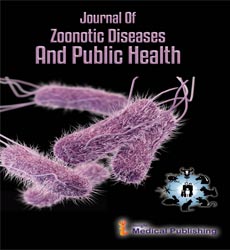Outbreak of Virus like Chickun Gunya and its Transmission
Vicki Everett*
Department of Science, University of Belgrade, Belgrade, Serbia
- *Corresponding Author:
- Vicki Everett
Department of Science,
University of Belgrade,
Belgrade,
Serbia,
E-mail: vicki.187@gmail.com
Received Date: September 17, 2021;Accepted Date: October 01, 2021; Published Date: October 08, 2021
Citation: Everett V (2021) Outbreak of Virus like Chickun Gunya and its Transmission. J Zoonotic Dis Public Health Vol.5 No.S1:e001.
Editorial Note
Chikungunya fever is a mosquito transmitted alphavirus infection that occurs in Africa and sothern and sotheastern Asia. In humans, it causes severe arthralgias and a maculopapular rash. The infection in monkeys causes a disease similar to dengue fever. It is clinically inapparent in birds. The name chikungunya comes from Swahili and means “what bends”.
Etiology is a causative agent of Chikungunya fever is a member of the family Togaviridae, genus related to O’nyong- nyong, Mayaro, Ross River, and Semliki Forest viruses but no other alphaviruses.
Occurrence virus isolation and demonstration of antibodies have been reported from Uganda, Tanzania, Zimbabwe, Angola, Zaire, and South Africa. It can be assumed that Chikungunya virus is present in all African countries south of the Sahara. In addition, there have been epidemics in numerous countries in southern and south eastern Asia.
Wild primates, bats, birds, and other animals appear to be agent reservoirs in Africa. Antibodies have been found in green monkeys, orang-utans, and chimpanzees. Recently it was reported that chikungunya virus has reached South America. In Columbia, 1900 cases were registered at the border with Venezuela. A baby aged 11 months died from this disease. Besides the urban infection cycle, there is possibly a rural or rainforest cycle, as there is in yellow fever. Chikungunya virus has a wide distribution in Southeast Asia, similar to that of dengue but unlike that of yellow fever. In southern asia outbreaks of chikungunya fever may be epidemiologically associated with dengue fever. In 2004, an epidemic of chikungunya was spread to countries around the Indian Ocean. Finally, the virus was introduced from Reunion to Italy, where the outbreak culminated in 2007 and established autochthonic infections.
Transmission Aedes aegypti was found to be the main vector in epidemics in large found to be the main vector in epidemics in large cities in Africa. It is assumed that humans are the main source of infection for mosquitoes and that vector-borne human to humans transmission is the rule in urban outbreaks. Direct transmission between humans was not observed. There is no vertical virus transmission in mosquitoes.
In Africa epidemics, vectors besides A. aegypti are Culex pipiens fatigens, Aedes africanus, A. furicifier taylori, and Mansonia species, A. furcifier taylori and A. africanus, are found in tropical rainforests and prefer wild primates as hosts. As was shown by the outbreaks in Italy in 2007, Aedes albopictus has gained considerable importance in distributing the Chikungunya virus.
Clinical Manifestations incubation period for Chikungunya virus is considered to be 6 to 10 days. It was only 22 and 80 h in two laboratory infections resulting from mosquito bites.
The disease begins suddenly with fever and joint that immediately causes patients to be unable to move. Back and limb pain can be so extensive that morphine is required. Other symptoms are myalgias, nausea, vomiting, headaches, nasal discharge, conjunctivitis, retrobulbar pain, photophobia, and lymphadenopathy. Fever lasts for 3 to 10 days and is often biphasic. A maculopapular rash develops around days 2 to 5. It can become hemorrhagic. Hemorhagic disease has not been reported in African epidemics. Hemorrhagic disease has been observed in 5% to 7% of cases in Asia.
Open Access Journals
- Aquaculture & Veterinary Science
- Chemistry & Chemical Sciences
- Clinical Sciences
- Engineering
- General Science
- Genetics & Molecular Biology
- Health Care & Nursing
- Immunology & Microbiology
- Materials Science
- Mathematics & Physics
- Medical Sciences
- Neurology & Psychiatry
- Oncology & Cancer Science
- Pharmaceutical Sciences
